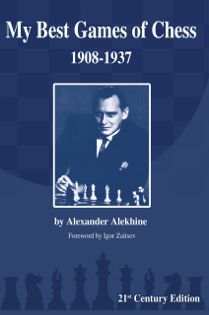My Best Games of Chess, 1908-1937
Alexander Alekhine

My Best Games of Chess, 1908-1937 by Alexander Alekhine is a collection of 220 games annotated by the renowned World Champion. The Russell Enterprises 2013 edition is a faithful algebraic notation version of the old descriptive notation Dover edition (my copy is 1985), itself a combination of Volumes 1 and 2 of the original Bell editions. As far as I can make out, the games and Alekhines notes are precisely the same as those in the old descriptive notation Dover edition, as is the J Du Mont memoir, which appeared at the beginning of the 2nd volume (Russell has, appropriately, moved it to the front of the book).
In this new edition, there are several extra features in addition to the move from descriptive to algebraic notation. The Editors Preface by Taylor Kingston contributes a brief but eloquent essay about Alekhine, who was a chess hero to Kingston as he first learned about chess. He gives an overview of Alekhines style and guides him through the text, for example: …Alekhines games have a quality or more accurately a combination of qualities and a stylistic variety, that are striking and unique. There are scintillating tactical brilliancies, such as against Bogoljubow at Hastings 1922, Asztalos at Kecskemet 1927, and Pirc at Bled 1931. His restless striving for the initiative, and his willingness to enter complications as against Vidmar at Carlsbad 1911, Levenfish at St. Petersburg 1914, or, most strikingly, Réti at Baden-Baden 1925 give his games an energy that made other masters seem torpid. He could produce positional masterpieces that showed deep strategic understanding (e.g., against Nimzowitsch at San Remo 1930, Menchik at Podebrady 1936, or Fine at Kemeri 1937). When attacking and combinative play was not feasible, he produced endgames of indomitable persistence and lethal technical precision.
Alekhine, like Botvinnik, Fischer, and Kasparov after him, was the leading opening researcher of his day. To quote Kingston again: Besides introducing the eponymous Alekhines Defense to master practice, he is credited by The Oxford Companion to Chess with no fewer than 19 Alekhine variations in such varied lines as the Dutch, Sicilian, French, Ruy Lopez, Queens Gambit (both Declined and Accepted), Slav, Semi-Slav, and Vienna Game. And his willingness to experiment with perhaps dubious but psychologically potent variations, and to hit opponents with unexpected novelties, was legendary. For example, his use of the Blumenfeld Counter-Gambit against Tarrasch at Bad Pistyan 1922, the Benoni against Bogoljubow and Gygli in two 1934 games, and, most strikingly, his piece sacrifice at the sixth move (!) against Euwe in their 1937 title match. All these elements combine to make Alekhines chess some of the most exciting, interesting, complex and beautiful ever played…
There is a 6-page foreword by Igor Zaitsev, in which he propounds the view that the young player should study the classics, because individual chess development progresses in the stages as the evolution of the game itself, just as if this individual were mimicking the law of biological development of an embryo (alas, he doesnt use the phrase with which I was inculcated, i.e., ontogeny recapitulates phylogeny). Zaitsev describes Alekhines contributions, e.g., related to initiative, attack, and combinations on both wings. He then shows examples of how Alekhines ideas informed his own play.
A 63-page supplement by Kingston (in rather small print, so theres a lot of material) is available on the web at Russell-enterprises.com. Its called Analytical Corrections, Additions and Enhancements for My Best Games of Chess 1908-1937. This is a huge effort, obviously heavily computer-checked and, especially for chess researchers, it adds significantly to the literature. It was possible to incorporate such corrections and comments within the games in the book itself, which has the advantage that you dont have to jump back and forth. This is how John Nunn did additions to the Batsford editions of classic books, which aroused some negative reaction at the time by purists. In retrospect, its amusing to see how unobtrusive and modest in scope these scattered footnotes are. But for lengthier and more serious annotations such as Kingston provides, I prefer his way of doing things, which doesnt interrupt the narrative feel of the annotations. Very few people will be reading such an older games collection while simultaneously playing over every move, and even fewer are expecting error-free analysis. Apart from the fact that we generally read these books impressionistically, most games are available on the computer for instant replay these days, and you can always put an analytical engine on if you want to see some of the more serious errors. With the method Kingston (and Russell Enterprises) is using, the analytically-minded reader or researcher can go to the website, and the majority of readers are spared extra clutter (in the sense of readability), as well as the expense of additional pages.
This is a book anyone interested in the play of the great champions will want to own.
